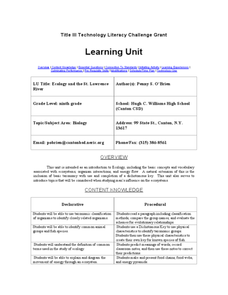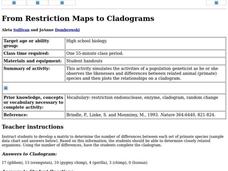Curated OER
Forest Friends Forever
Students investigate how to use the senses to gather information about objects such as size, shape, color, texture, sound, position, and change (qualitative observations are utilized throughout this lesson). They investigate and explain...
Curated OER
Why Do Geese Fly South For the Winter?
Fifth graders examine migration by tracing animal migration routes on a map. For this animal life lesson, 5th graders observe a map of North America and read about the migration patterns of geese. Students trace the path most...
Curated OER
Environmental Action
Students investigate an environmental problem in order to find and propose possible solutions. The problem is real to add to the engagement of the instructional activity. This is found through conducting research and then brainstorming...
Curated OER
How Do They Know That
Students explore methods for reconstructing the past. In this forest succession lesson, students examine forest succession and how to read the land in order to predict patterns of change. Students will visit a historical site, act as an...
Curated OER
Management of Commercial Fisheries, Part 2
Learners examine the differences between the past vs. the present fishing and the uses of fisheries. In this investigative lesson students complete a worksheet and learn to think critically in order to protect our environment.
Curated OER
Management of Commercial Fisheries, Part 3
Students search the Internet and write a research paper on the environment. In this investigative lesson plan students develop a paper on fisheries and management of them.
Curated OER
Giants of the Protozoa
Students describe and define xenophyophores. In this protozoa lesson students divide into groups and complete a lab activity.
Curated OER
The Changing Coral Reef Community Game
Students examine organisms that inhabit the coral reefs and their living requirements. In this coral reef lesson students chart population changes and play a game.
Curated OER
Acid Rain And Geology
Learners become aware of the environmental problems caused by acid rain and study the pH scale. They determine acidity of local rain water.
Curated OER
Cancer Treatments
Students explore the different kinds of treatments available for cancer and what their dangers or side effects are. They discover how often patients get treated, and how expensive the treatments are.
Curated OER
Monitoring Aquatic Ecosystems Lesson Plan
Students perform an experiment to test the quality of the water in a marsh.
Curated OER
Ecology and the St. Lawrence River
Ninth graders complete a unit of lessons on ecosystems, organism interactions, and energy flow. They create a key for known species of fish, diagram the movement of energy through an ecosystem, and create and present food chains and food...
Curated OER
Habitats and Functions
Students use a large seet of habitat cards, spread out in one area. They, in groups, practice sorting themselves into the correct habitat based on what function card they received.
Curated OER
The Ultimate Predator
Students already know that the most effective predator on earth today. They pay close attention, because after the teacher have finished lecturing, their assignment is to design a new "Ultimate Predator." Students present their...
Curated OER
From Restriction Maps to Cladograms
Students develop a matrix to determine the number of differences between each set of primate species. They determine closely related organisms then complete the cladogram and answer a set of questions.
Curated OER
The Ultimate Predator
Students listen to a lecture by the teacher about the "Ultimate Predator." They design a new "Ultimate Predator." Students present their creations to the class and attempt to convince their classmates that their predator is indeed the...
Curated OER
DNA Sequencing Simulation
High schoolers simulate the Sanger method of DNA sequencing using color pop-beads as a representation of nucleotides and dideoxynucleotides. Students assemble DNA sequences and run their sequences through a "sequencing gel" and sketch...
Curated OER
Using A Winogradsky Column to Analyze Microbial Communities
Students use easily obtained materials to study ecological succession in a microbiological community. This investigation is appropriate for a variety of age groups. Elementary Students be fascinated by the changes occurring over time...
Curated OER
Down, Dung and Dirty
Students investigate the stages of succession in animal dung communities. They create a dung culture using fresh cow, goat or horse dung then record data on the fungal species that appear over a two week period.
Curated OER
Plant And Animal Adaptations
Students examine plant and animal life while looking at the environments the organismisms live in. They determine how form follows function by looking an aquatic turtle and noticing its feature of adaptation features. They work in groups...
Curated OER
Environet Lesson Plans
Eleventh graders conduct Internet research about basic ecological principles and current environmental issues. They participate in a variety of outdoor experiences and develop an "Outdoor Experiences Journal" that they keep for an...
Curated OER
ARE WE IN THE MIDDLE OF A MASS EXTINCTION?
Students identify and interpret the following: What is mass extinction, and what are some theories for why it happens? How often do species become extinct? What is the normal rate of extinction? Why are some species endangered? What...
Curated OER
Invertebrates
Learners identify the characteristics common to all animals. In groups, they compare the characteristics between the animals and how they are divided. To end the lesson, they compare the eight phyla of invertebrates and review the...
Curated OER
Water Quality Tests Explained
Students define all eight water quality parameters and list at list one source for each of the eight water quality parameters. They determine how each of the eight parameters affect river ecosystems.























